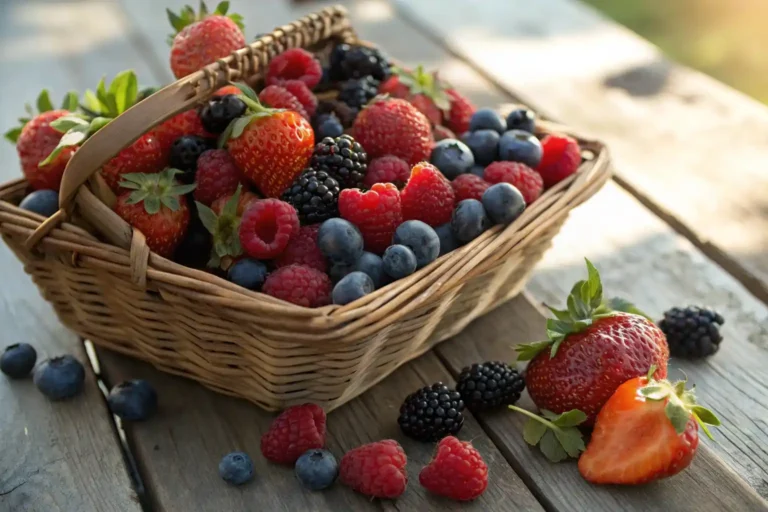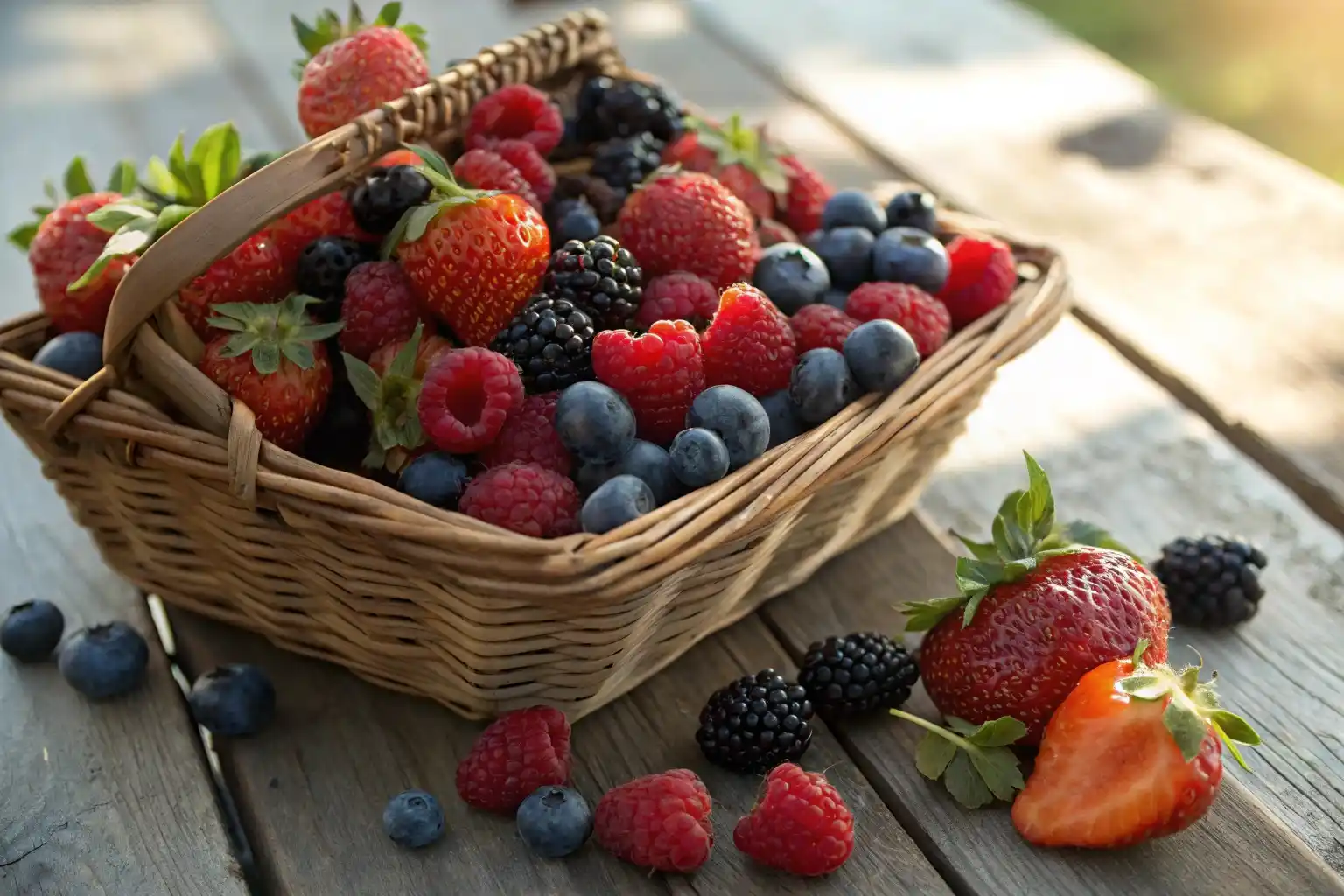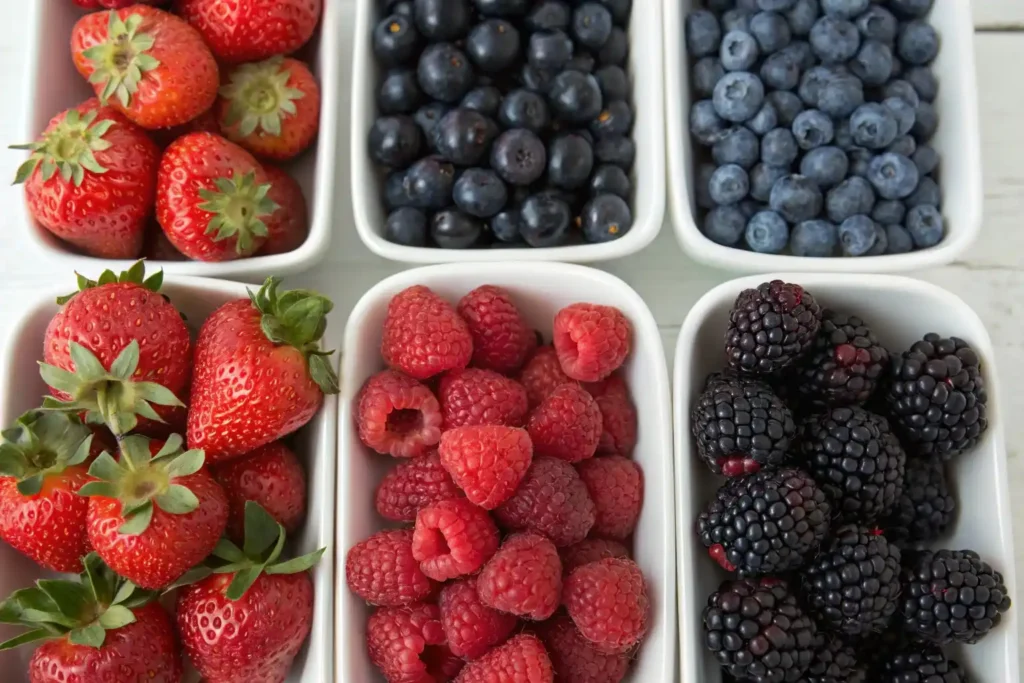Nature’s Sweet Jewels
Summer berries are among nature’s most perfect creations—bursting with flavor, packed with nutrients, and beautifully vibrant in color. From the delicate sweetness of strawberries to the tart complexity of raspberries, these seasonal gems are the foundation of countless desserts, including the viral raspberry spuma that has taken social media by storm as one of the most popular viral food trends. This comprehensive guide will help you navigate the world of summer berries, teaching you how to select the best fruit, store it properly, and transform it into spectacular desserts that celebrate the season’s bounty.
The Summer Berry Lineup: A Seasonal Calendar
Early Summer (May-June)
Strawberries are typically the first berries to ripen in most regions, heralding the start of berry season. Their sweet, aromatic flavor and juicy texture make them perfect for everything from simple fruit salads to elaborate desserts.
Rhubarb (technically a vegetable but used like a fruit) also peaks in early summer, offering a tart counterpoint that pairs beautifully with sweeter berries.
Mid-Summer (June-July)
Raspberries reach their peak during mid-summer, offering their distinctive sweet-tart flavor and delicate texture. Red raspberries are most common, but golden varieties offer a milder, sweeter taste.
Blueberries begin their season in mid-summer, providing bursts of sweet, slightly floral flavor and impressive nutritional benefits.
Currants (red, white, and black) also ripen during this period, offering intense, tart flavors that are excellent for jams and sophisticated desserts.
These peak-season raspberries are ideal for creating the perfect raspberry spuma, where their natural sweet-tart balance creates the signature flavor that has made this dessert so popular in healthy summer desserts collections.
Late Summer (July-August)
Blackberries typically ripen in late summer, offering deep, complex flavors that range from sweet to slightly tart depending on the variety.
Elderberries and huckleberries also peak during this time in certain regions, providing unique flavors for adventurous cooks.
Selecting the Perfect Berries
Visual Inspection
The first step in choosing quality berries is a thorough visual inspection:
Color: Look for berries with vibrant, uniform color. Strawberries should be bright red with no white or green areas. Raspberries should have deep, rich color—red, golden, or black depending on the variety. Blueberries should have a deep blue color with a silvery bloom.
Shape and Size: While size doesn’t always indicate quality, berries should be plump and well-formed. Avoid berries that appear shriveled, misshapen, or have soft spots.
Surface Quality: The skin should be smooth and intact. Avoid berries with cuts, bruises, or signs of mold. For raspberries and blackberries, check that the individual drupelets (the small round sections) are intact and not leaking.
The Container Check
Don’t just look at the berries on top—gently lift the container and check the bottom for:
- Juice stains: These indicate overripe or damaged berries
- Mold: Even one moldy berry can quickly spread to others
- Crushed berries: These will deteriorate quickly and affect the quality of surrounding fruit
Seasonal Timing
Peak season berries are almost always superior in flavor and value. Local, in-season berries will be:
- More flavorful due to optimal ripeness at harvest
- Less expensive due to abundant supply
- More nutritious, as they haven’t lost vitamins during long transport
- More environmentally friendly due to reduced shipping
Proper Storage Techniques
Immediate Care
Don’t wash until ready to use: Excess moisture promotes mold growth and speeds deterioration. Only rinse berries just before eating or cooking.
Remove damaged berries: Sort through your berries and remove any that are overripe, damaged, or showing signs of mold. One bad berry can quickly affect the entire container.
Keep them cool: Berries are highly perishable and should be refrigerated as soon as possible after purchase.
Refrigerator Storage
Temperature: Store berries in the coldest part of your refrigerator, typically the back of the main compartment, at 32-36°F (0-2°C).
Humidity: Berries need some humidity to prevent drying out, but too much promotes mold. Most refrigerator crisper drawers provide the right balance.
Container choice:
- Keep berries in their original containers if they’re well-ventilated
- Transfer to shallow containers lined with paper towels if the original packaging is damaged
- Avoid airtight containers, which can trap moisture and promote mold
Freezing for Long-Term Storage
Freezing is an excellent way to preserve berries for use in desserts like spuma, smoothies, and baked goods:
Preparation: Rinse berries gently and pat completely dry. Remove stems and any damaged areas.
Flash freezing: Spread berries in a single layer on a baking sheet lined with parchment paper. Freeze until solid (about 2-3 hours), then transfer to freezer bags or containers.
Storage: Properly frozen berries can last 8-12 months in the freezer. Label containers with the date and type of berry.
Usage tips: Frozen berries work excellently in cooked applications and blended desserts. For spuma, you can use frozen berries directly—just thaw and drain excess liquid first.
Berry-Specific Handling Tips
Strawberries
- Hull after washing: Remove the green tops after rinsing to prevent water from entering the berry
- Size matters for recipes: Large strawberries are great for eating fresh, while smaller ones often have more concentrated flavor for desserts
- Ripeness test: Ripe strawberries should have a sweet aroma at the stem end
Raspberries
- Handle gently: Raspberries are extremely delicate and bruise easily
- Check the hollow: Fresh raspberries should easily separate from their white core, leaving a hollow center
- Color variations: Red raspberries are most common, but golden varieties are sweeter and less acidic
Blueberries
- The bloom test: Fresh blueberries should have a silvery “bloom” on their surface—this natural coating helps preserve freshness
- Size and firmness: Larger blueberries aren’t necessarily better; focus on firmness and color
- Storage advantage: Blueberries typically last longer than other berries when properly stored
Blackberries
- Cluster integrity: The individual drupelets should be firmly attached and uniformly colored
- Thorough inspection: Check carefully for small insects, which are sometimes found in wild or organic blackberries
- Ripeness indicators: Ripe blackberries should be deep black (not red or purple) and slightly soft
Using Berries in Desserts
Preparation Techniques
For Fresh Applications
- Gentle washing: Rinse berries in cool water just before use
- Proper drying: Pat dry with paper towels or use a salad spinner lined with paper towels
- Strategic cutting: For strawberries, slice just before serving to prevent juice loss
For Cooked Applications
- Macerating: Toss berries with sugar and let sit for 15-30 minutes to draw out natural juices
- Flour coating: For baked goods, toss berries in a small amount of flour to prevent sinking
- Acid balance: Add a squeeze of lemon juice to enhance flavor and help maintain color
Berry Dessert Applications
Raspberry Spuma Variations
The basic raspberry spuma recipe can be adapted for other berries, making it one of the most versatile healthy summer desserts:
- Strawberry spuma: Use hulled strawberries; may need slightly more sugar due to higher water content
- Blueberry spuma: Blend thoroughly to break down the skin; strain for ultra-smooth texture
- Mixed berry spuma: Combine 2-3 berry types for complex flavor profiles
For those with dietary restrictions, explore our vegan raspberry spuma using aquafaba, or try the cooked syrup method for enhanced food safety. You can even transform your spuma into a frozen treat with raspberry spuma ice cream techniques.
Classic Berry Desserts
Berry compotes: Gently cook berries with sugar and a splash of lemon juice for a versatile topping
Fresh berry tarts: Arrange perfect berries on pastry cream or mascarpone for elegant presentation
Berry fools: Layer whipped cream with crushed berries for a simple, traditional British dessert
Sorbets and granitas: Pure fruit flavors shine in these frozen treats
Modern Berry Dessert Techniques
Understanding the differences between spuma, mousse, and espuma can help you choose the best preparation method for different berries. The light, airy texture of spuma particularly suits delicate berries like raspberries, while denser berries like blueberries might benefit from traditional mousse preparations.
For food safety considerations, especially when working with egg-based desserts during warm summer months, consult our guide on raw egg safety to ensure your berry desserts are both delicious and safe.
Flavor Pairing Suggestions
Understanding which flavors complement different berries can elevate your desserts:
Strawberries pair well with: Vanilla, balsamic vinegar, basil, rhubarb, chocolate Raspberries pair well with: Lemon, rose, chocolate, almonds, peaches Blueberries pair well with: Lemon, lavender, ginger, cinnamon, cream cheese Blackberries pair well with: Apples, pears, sage, honey, yogurt
Nutritional Benefits of Summer Berries
Beyond their delicious taste, summer berries are nutritional powerhouses:
Antioxidants
All berries are rich in anthocyanins, the compounds responsible for their vibrant colors. These antioxidants help protect cells from damage and may reduce the risk of chronic diseases.
Vitamin C
Most berries are excellent sources of vitamin C, supporting immune function and collagen production. Strawberries are particularly high in this essential vitamin.
Fiber
Berries provide both soluble and insoluble fiber, supporting digestive health and helping to regulate blood sugar levels.
Low Glycemic Impact
Despite their sweetness, most berries have a relatively low glycemic index, making them a smart choice for blood sugar management.
Perfect for Health-Conscious Desserts
These impressive nutritional profiles make summer berries ideal for healthy summer desserts that don’t compromise on taste. The natural antioxidants and low calorie content of berries allow you to create indulgent-tasting treats that actually contribute to your wellness goals.
Seasonal Preservation Methods
Traditional Techniques
Jam and preserves: Classic methods that concentrate flavors and extend shelf life Dehydrating: Creates concentrated, chewy treats perfect for snacking or baking Canning: Proper canning techniques can preserve berries for year-round enjoyment
Modern Approaches
Vacuum sealing: Extends fresh berry life when combined with proper refrigeration Freeze-drying: Maintains texture and nutrition better than traditional freezing Puree and freeze: Blend berries into purees and freeze in ice cube trays for easy portioning
Conclusion: Embracing the Berry Season
Summer berries represent one of the season’s greatest pleasures—the perfect intersection of incredible flavor, beautiful appearance, and impressive nutrition. By understanding how to select, store, and use these precious fruits, you can make the most of their brief but glorious season.
Whether you’re creating a simple raspberry spuma, trying the vegan aquafaba version, experimenting with the cooked syrup method, an elaborate berry tart, or just enjoying them fresh from the container, the key is to start with the best possible fruit and treat it with the respect it deserves. With proper selection and storage techniques, you can extend the enjoyment of summer berries well beyond their natural season, bringing a taste of summer sunshine to your table year-round.
Remember that the best berry dessert is often the simplest one—sometimes all these natural gems need is a little sugar, a gentle touch, and an appreciation for the fleeting beauty of the season. As these berry-based desserts continue to trend in viral food trends, you’ll have the knowledge to create both beautiful and delicious healthy summer desserts that celebrate the season’s finest offerings.
Print
Guide to Summer Berries for the Best Seasonal Desserts
From strawberries to elderberries, learn how to select, store, and use summer’s sweetest gifts in desserts like raspberry spuma, berry tarts, sorbets, and more.
- Total Time: 10 minutes (plus optional freezing or preserving)
- Yield: Varies by recipe
Ingredients
- Fresh summer berries (strawberries, raspberries, blueberries, blackberries)
- Lemon or lime juice
- Sugar, honey, or sweetener of choice
- Whipped egg whites (for spuma)
- Pastry cream or mascarpone (for tarts)
- Whipping cream (for fools)
- Mint, basil, or other herbs
- Optional: balsamic vinegar, rose water, spices
Instructions
- Select ripe, vibrant berries based on season—strawberries (early summer), raspberries and blueberries (mid-summer), blackberries (late summer).
- Inspect berries for even color, plumpness, and no signs of mold or juice stains. Check the bottom of the container.
- Store unwashed in original ventilated container or shallow paper towel-lined container. Refrigerate immediately at 32–36°F.
- For long-term use, flash freeze cleaned and dried berries on a tray before transferring to freezer-safe bags.
- Prepare berries based on dessert use: macerate for compotes, toss in flour for baking, or blend for spuma or sorbets.
- Make berry spuma using your choice of berries, adjusting sugar and straining if needed (especially for blueberry or mixed berry).
- Create tarts, fools, sorbets, and granitas using prepared berries and flavor pairings like lemon, chocolate, basil, and ginger.
Notes
Choose berries in season for best flavor and value. Use frozen berries for cooked or blended recipes. Mix and match flavors with herbs, citrus, or spices. Handle raspberries gently, don’t wash berries until ready to use, and avoid airtight storage containers. Try drying, preserving, or freezing berries to enjoy them year-round.
- Prep Time: 10 minutes
- Cook Time: 0 minutes
- Category: Dessert
- Method: No Bake / Fresh / Frozen
- Cuisine: Seasonal
Nutrition
- Serving Size: 1 portion
- Calories: 90
- Sugar: 10g
- Sodium: 5mg
- Fat: 1g
- Saturated Fat: 0g
- Unsaturated Fat: 1g
- Trans Fat: 0g
- Carbohydrates: 14g
- Fiber: 4g
- Protein: 2g
- Cholesterol: 0mg
Keywords: summer berries, berry desserts, raspberry spuma, seasonal fruit, berry storage, berry selection


